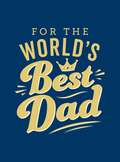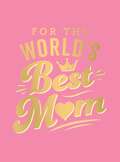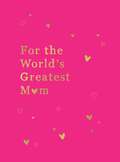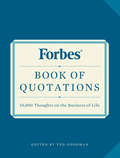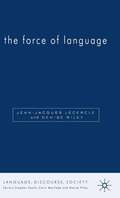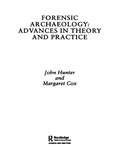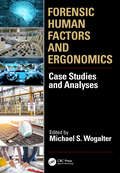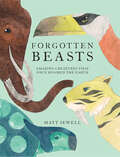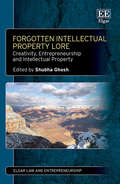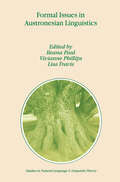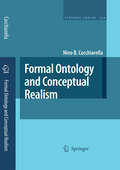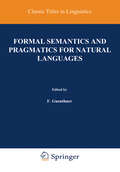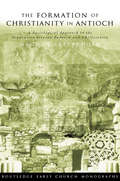- Table View
- List View
For the World's Best Dad: The Perfect Gift to Give to Your Father
by Summersdale PublishersDads deserve a major shout-out for everything that makes them great. This little book, filled with top-quality quotes and standout statements, will let your dad know just how much you love him. It’s the perfect keepsake to remind him that he really is the world’s best dad.
For the World's Best Mum: The Perfect Gift to Give to Your Mum
by Summersdale PublishersCelebrate everything you love about you mother with this little book, filled with hand-picked quotes and thoughtful words to show her just how incredible she is. It’s the perfect keepsake to remind her that she really is the world’s best mum.
For the World's Greatest Mum: The Perfect Gift for Your Mum
by Summersdale PublishersLet your mum know just how much you care with this delightful collection of heart-warming quotes and sentimental statementsThere’s nobody quite like a mother – she’s always there for you, no matter what, giving comfort, counsel and care. And, however old you are, you’ll never stop being her child!She deserves the sun, moon and stars, but if you can’t manage that this little book is the next best thing. Inside you’ll find a host of glittering quotations from around the world – whether from actors, writers, musicians or leaders from all walks of life, they all have something heartfelt and inspiring to say about their relationship with their mum or about their experience of being a mum. To make it even more special, there’s a sprinkling of sentimental statements illustrating the kind and generous things mothers are known for best.This is the perfect love bomb to let your mum know she’s the world’s greatest!
Forbes Book of Quotations: 10,000 Thoughts on the Business of Life
by Ted GoodmanRevised and updated, this bestselling collection of business wit and wisdom is the ultimate desk reference for the cube and corner office, by one of the world's most popular business publications. Forbes is one of the world's most trusted, recognizable, and growing brands in business news and information both in print and online. This comprehensive collection of business quotations gathers more than 10,000 apt, astute, and motivational remarks on scores of topics, organized alphabetically, from "Ability" to "Excellence" to "Salesmanship." First published in 1997, this all new edition is updated with hundreds of new quotations, from the likes of Steve Jobs, Sheryl Sandberg, and Oprah Winfrey that pertain to modern business culture. Forbes Book of Quotations is the perfect gift or reference tool for students, budding entrepreneurs, and seasoned professionals alike, or anyone looking for a sharp-witted way to make a lasting impression.
Forbes Book of Quotations: 10,000 Thoughts on the Business of Life
by Ted GoodmanRevised and updated, this bestselling collection of business wit and wisdom is the ultimate desk reference for the cube and corner office, by one of the world's most popular business publications. Forbes is one of the world's most trusted, recognizable, and growing brands in business news and information both in print and online. This comprehensive collection of business quotations gathers more than 10,000 apt, astute, and motivational remarks on scores of topics, organized alphabetically, from "Ability" to "Excellence" to "Salesmanship." First published in 1997, this all new edition is updated with hundreds of new quotations, from the likes of Steve Jobs, Sheryl Sandberg, and Oprah Winfrey that pertain to modern business culture. Forbes Book of Quotations is the perfect gift or reference tool for students, budding entrepreneurs, and seasoned professionals alike, or anyone looking for a sharp-witted way to make a lasting impression.
The Force of Language (Language, Discourse, Society)
by D. Riley J. LecercleThe Force of Language illustrates how the philosophy of Language, if differently conceived, can directly incorporate questions of political thought and of emotionality, and offers the practical case of defensive strategies against the abusive speech. This follows a broad consideration of the inner voice or inner speech as a test case for a new approach to language, in particular as a way of radically rethinking the usual contrast between inner and outer through furnishing an account of how we internalize speech. The book's core offers a substantial critique of orthodox approaches to the philosophy of language form Chomsky and others; drawing on European political thought from Marx to Deleuze, it will move beyond this inheritance to explain and demonstrate its fresh conception of language at work.
The Force of Law Reaffirmed: Frederick Schauer Meets the Critics (Law and Philosophy Library #117)
by Christoph Bezemek Nicoletta LadavacThis book examines the success of Frederick Schauer’s efforts to reclaim force as a core element of a general concept of law by approaching the issue from different legal traditions and distinct perspectives. In discussing Schauer’s main arguments, it contributes to answering the question whether force, sanctions and coercion should (or should not) be regarded as necessary elements of the concept of law, and whether legal philosophy should be concerned at all (or exclusively) with necessary or essential properties.While it was long assumed that legal norms are essentially defined by their force, it was H.L.A. Hart who raised doubts about whether law and coercion are necessarily connected, referring to the empowering, or more generally enabling, character exhibited by some legal norms. Prominent scholars following and refining Hart’s argument built an influential case for excluding force as a necessary element of the concept of law. Most recently, however, Frederick Schauer has made a strong case to reaffirm the force of law, shedding new light on this essential question. This book collects important commentaries, never before published, by prominent legal philosophers evaluating Schauer’s substantive arguments and his claims about jurisprudential methodology.
Ford Capri: The Essential Buyer’s Guide (Essential Buyer's Guide)
by Mark PaxtonWhen launched, the Ford Capri was revolutionary. It was a car that set the European market alight, allowing even a buyer on a modest budget an intoxicating whiff of the exotic whilst keeping running costs at affordable levels. That status eroded over time, and the Capri sat in the classic car doldrums for many years, its true worth unrecognised. That situation has thankfully changed, and Capri values are rising rapidly, so care has to be taken to make sure you end up with the best one possible for your money. This guide takes the potential purchaser through a short initial examination to weed out the obviously defective followed by a more comprehensive step by step look at the body and mechanical parts, where the clear, jargon-free text accompanied by over 100 photographs sheds light on even the darkest corners of the Capri's construction. A unique points marking system ensures that nothing is overlooked, and an accurate final picture of the car's condition can be viewed in relation to the asking price.
Ford Cleveland 335-Series V8 engine 1970 to 1982: The Essential Source Book (Essential Source Book)
by Des HammillThe definitive history of 335-Series Cleveland Small Block Ford V8 Engines produced in the USA, Canada and Australia between 1970-1982. Years of meticulous and dedicated research have allowed Des Hammill to collate extensive and accurate information to produce this fully comprehensive, unique technical appraisal of the Ford V8 Cleveland engines, including previously undocumented knowledge from both the engineers and engine plants involved in the design, development and subsequent manufacture of this highly prized engine from its inception in 1968 until production ceased in 1982. Coverage includes Ford engine plants, all Cleveland 335 variants, cylinder heads, preparation for racing, camshafts, technical data, racing history in NASCAR and Pro-Stock; in fact, just about everything you could wish to know about this classic engine. This is one of an informative series of books depicting the history of the individual series of Ford overhead valve V8 engines.
Ford Escort Mk1 & Mk2: The Essential Buyer's Guide: All models 1967 to 1980 (Essential Buyer's Guide)
by Dan WilliamsonFord's rear-wheel-drive Escorts achieved legendary status through their amazing success - on roads, rally stages, and racetracks. Millions were sold worldwide, and they proved to be winners in the hands of the car-buying public and motorsport champions alike. Today, Mk1s and Mk2s (1967 to 1980) have become collectable classics, and values continue to rise, often equalling traditionally more desirable marques. This book is a handy, quick-reference guide for anyone considering buying, owning, or restoring an early Escort. It aims to aid the purchasing process and help to avoid the potential pitfalls of a car that's not only simple to work on, but also easy to bodge for an overpriced sale.Written by a motoring journalist and long-term Escort enthusiast, this one-stop package of great advice is the ideal accompaniment to sampling and assessing a Mk1 or Mk2 on sale privately, at a dealer, or an online auction.It includes at-a-glance tips, illustrated in-depth inspection guidance, valuation data, specifications, notes on modifications to avoid, real-world cost considerations, and even checks on how to spot an Escort claiming to be something it's not.
Ford RS Cosworth Sierra & Escort: The Essential Buyer's Guide: All models 1985-1996 (Essential Buyer's Guide)
by Dan WilliamsonFord's legendary Sierra and Escort RS Cosworths conquered worldwide motorsport, while changing the face of high-performance road cars forever. With turbocharged two-litre engines producing over 200bhp, these four-seater everyday saloons could keep pace with supercars - and their 500bhp-plus circuit-racing counterparts overwhelmed everything in sight.Even now, Sierra and Escort RS Cosworths are in touch with modern machinery, making them as desirable to keen drivers as they are to classic collectors. The RS500 in particular is a rare beast, commanding prices normally befitting upmarket brands.Sadly, many Cosworths were stolen, abused, crashed, copied, neglected, and modified, which makes buying one today a task that's fraught with risk.To help the would-be RS Cosworth owner, this quick-reference guide acts as a handy pocket-sized companion during the purchasing process. It aims to help buyers select the best car, pay the right price, and avoid the potential pitfalls.Written by a motoring journalist and long-term Cosworth enthusiast, this one-stop package of great advice includes at-a-glance tips, illustrated in-depth inspection guidance, specifications, notes on modifications, real-world cost considerations, and even checks to help spot a fake.
Foreign Phrases (Collins Word Power)
by Graham KingThe plain guide to the most commonly used foreign words in the English language from the world word bank.
Forensic Anthropology: Current Methods and Practice
by Angi M. Christensen Nicholas V. Passalacqua Eric J. BartelinkForensic anthropology has seen a recent expansion in depth and scope as well as increased attention from the media and the legal system. This constantly evolving science requires a comprehensive introductory text that approaches forensic anthropology as a modern discipline, with attention to theory as well as recent advances in research, technology, and challenges in the field. Forensic Anthropology: Current Methods and Practice, 2nd edition approaches forensic anthropology using current practices and case studies drawn from the varied experiences, backgrounds, and practices of working forensic anthropologists. This text guides the reader through all aspects of human remains recovery and forensic anthropological analysis. It presents principles at a level that is appropriate for those new to the field, while at the same time incorporating evolutionary, biomechanical, and other theoretical foundations for the features and phenomena encountered in forensic anthropological casework. Attention is focused on the most recent and scientifically valid applications commonly employed by working forensic anthropologists. Readers will learn about innovative techniques in the discipline, and aspiring practitioners will be prepared by understanding the necessary background needed to work in the field today. Instructors and students will find Forensic Anthropology: Current Methods and Practice, 2nd edition comprehensive, practical, and relevant to the modern discipline of forensic anthropology. - Focuses on current methods, advances in research and technology, and recent challenges in the science of forensic anthropology - Addresses issues of international relevance such as the role of forensic anthropology in mass disaster response and human rights investigations - Includes chapter summaries, topic-oriented case studies, keywords, and reflective questions to increase active student learning
Forensic Archaeology: Advances in Theory and Practice
by Margaret Cox John HunterThis updated edition of a textbook universally hailed as an indispensable guide, is a complete introduction to the methods and means of forensic archaeology. Incorporating new advances in the field, new case studies, and charting the growth and development of the subject, Forensic Archaeology examines the four main fields of recovery, search, skeletal analysis and analytical science, and how the concepts and methods of traditional archaeology can by utilized within criminal investigations. The authors provide in-depth chapters that discuss: search and location the various constraints and issues posed by an increasingly complex legal environment the archaeology of individual and mass graves how the subject has evolved to include international investigations of human rights links with forensic anthropology forensic geophysical survey. This is an invaluable resource that will provide students, researchers, academics and the general reader alike with a fascinating introduction to this complex and crucial subject.
Forensic Archaeology: Advances in Theory and Practice
by Margaret Cox John HunterThis updated edition of a textbook universally hailed as an indispensable guide, is a complete introduction to the methods and means of forensic archaeology. Incorporating new advances in the field, new case studies, and charting the growth and development of the subject, Forensic Archaeology examines the four main fields of recovery, search, skeletal analysis and analytical science, and how the concepts and methods of traditional archaeology can by utilized within criminal investigations. The authors provide in-depth chapters that discuss: search and location the various constraints and issues posed by an increasingly complex legal environment the archaeology of individual and mass graves how the subject has evolved to include international investigations of human rights links with forensic anthropology forensic geophysical survey. This is an invaluable resource that will provide students, researchers, academics and the general reader alike with a fascinating introduction to this complex and crucial subject.
Forensic Human Factors and Ergonomics: Case Studies and Analyses (Human Factors and Ergonomics)
by Michael S. WogalterThis book has 18 case study chapters investigating various injury scenarios through the use of a Human Factors and Ergonomics (HFE) analysis. Each injury scenario derives from one or more similar lawsuits (but names, places and some of the details are fictionalized). The scenarios describe a ‘slice of life’ of people interacting with products, equipment, tasks, and environments before they are seriously hurt. The forensic analysis that follows each scenario gives a background of prior similar events and systematically examines potential causes leading to the injury event. There is emphasis on the person-machine interface, human error, hazard analysis, hazard control and a model of communication-human information processing (C-HIP). Chapters are authored by highly experienced expert witnesses in HFE. The methods used are general techniques that can be applied to other injury scenarios, but would be better if employed earlier in a product’s life cycle to prevent or limit injury. The first three chapters introduce concepts useful for the analyses in the case study chapters. The last chapter offers some broad take-away points that cut across several of the case studies. Features contributions by persons who have extensive experience in HFE and who have served professionally in the role of an expert witness in various legal cases mostly in product liability Gives a broad range of situations to illustrate where HFE considerations could improve product or environmental safety. There is an emphasis on children/caregivers, and adult activities such as driving Uses mitigation strategies to reduce the likelihood of occurrence and severity of adverse events Includes a first-person scenario at the beginning of each chapter Allows the lessons learned to be adaptable to other domains where people interact with products and environments
Forensic Human Factors and Ergonomics: Case Studies and Analyses (Human Factors and Ergonomics)
by Michael S. WogalterThis book has 18 case study chapters investigating various injury scenarios through the use of a Human Factors and Ergonomics (HFE) analysis. Each injury scenario derives from one or more similar lawsuits (but names, places and some of the details are fictionalized). The scenarios describe a ‘slice of life’ of people interacting with products, equipment, tasks, and environments before they are seriously hurt. The forensic analysis that follows each scenario gives a background of prior similar events and systematically examines potential causes leading to the injury event. There is emphasis on the person-machine interface, human error, hazard analysis, hazard control and a model of communication-human information processing (C-HIP). Chapters are authored by highly experienced expert witnesses in HFE. The methods used are general techniques that can be applied to other injury scenarios, but would be better if employed earlier in a product’s life cycle to prevent or limit injury. The first three chapters introduce concepts useful for the analyses in the case study chapters. The last chapter offers some broad take-away points that cut across several of the case studies. Features contributions by persons who have extensive experience in HFE and who have served professionally in the role of an expert witness in various legal cases mostly in product liability Gives a broad range of situations to illustrate where HFE considerations could improve product or environmental safety. There is an emphasis on children/caregivers, and adult activities such as driving Uses mitigation strategies to reduce the likelihood of occurrence and severity of adverse events Includes a first-person scenario at the beginning of each chapter Allows the lessons learned to be adaptable to other domains where people interact with products and environments
Forgotten Beasts: Amazing Creatures That Once Roamed The Earth
by Matt SewellWhat do you know about the our planet's strangest extinct creatures? Less celebrated than the dinosaurs, these beasts are equally impressive. Enjoy Matt Sewell's characteristic watercolour illustrations and witty, fascinating descriptions of these amazing creatures that once did stalk the planet.
Forgotten Intellectual Property Lore: Creativity, Entrepreneurship and Intellectual Property (Elgar Law and Entrepreneurship series)
This innovative book explores forgotten disputes over intellectual property and the ways in which authors, inventors, publishers, courts, and sovereigns have managed these disputes throughout the centuries. With an eye on reform, it chronicles the resilience of legal rules and challenges the methodology behind traditional legal analyses. Disentangling lore from traditions, expert contributors incorporate contextual understandings that are rooted in history, sociology, political science, and literary studies into their analyses. They explore the context of particular cases to reveal the ramifications of specific doctrines for the evolution of intellectual property practices. Chapters illuminate the various facets of intellectual property lore: contract, authorship, common law, and wartime property. Utilising novel methods and previously unpublished materials on copyright, patent, and trademark law, the book examines legal history and developments from multiple perspectives. This rich and accessible book will prove to be a valuable resource for students, academics of intellectual property law, and legal historians. Its use of new materials and exploration of key cases will also be beneficial for intellectual property legal practitioners.
Formal Issues in Austronesian Linguistics (Studies in Natural Language and Linguistic Theory #49)
by I. Paul V. Phillips Lisa TravisAustronesian languages have long raised interesting questions for generative theories of syntax and morphology. The papers in this volume encompass some of these traditional questions and place them in newer theoretical contexts. Some of the papers also address new issues which add to our understanding of members of this language family on one side and the nature of linguistic theories on the other. There are three broad issues that re-occur throughout the volume - the role and analysis of verbal morphology, the nature of the subject or the topic in these languages, and the interaction of syntax and specificity. The papers in this volume show that as formal theories become more precise, a wider range of language data can be captured, and as the inventory of language data grows, the accuracy of formal linguistic theories improves.
Formal Modeling in Social Science
by Carol Mershon Olga ShvetsovaA formal model in the social sciences builds explanations when it structures the reasoning underlying a theoretical argument, opens venues for controlled experimentation, and can lead to hypotheses. Yet more importantly, models evaluate theory, build theory, and enhance conjectures. Formal Modeling in Social Science addresses the varied helpful roles of formal models and goes further to take up more fundamental considerations of epistemology and methodology. The authors integrate the exposition of the epistemology and the methodology of modeling and argue that these two reinforce each other. They illustrate the process of designing an original model suited to the puzzle at hand, using multiple methods in diverse substantive areas of inquiry. The authors also emphasize the crucial, though underappreciated, role of a narrative in the progression from theory to model. Transparency of assumptions and steps in a model means that any analyst will reach equivalent predictions whenever she replicates the argument. Hence, models enable theoretical replication, essential in the accumulation of knowledge. Formal Modeling in Social Science speaks to scholars in different career stages and disciplines and with varying expertise in modeling.
Formal Ontology and Conceptual Realism (Synthese Library #339)
by Nino B. CocchiarellaTheories about the ontological structure of the world have generally been described in informal, intuitive terms. This book offers an account of the general features and methodology of formal ontology. The book defends conceptual realism as the best system to adopt based on a logic of natural kinds. By formally reconstructing an intuitive, informal ontological scheme as a formal ontology we can better determine the consistency and adequacy of that scheme.
Formal Semantics and Pragmatics for Natural Languages (Studies in Linguistics and Philosophy #4)
by Franz Guenthner Siegfried J. SchmidtThe essays in this collection are the outgrowth of a workshop, held in June 1976, on formal approaches to the semantics and pragmatics of natural languages. They document in an astoundingly uniform way the develop ments in the formal analysis of natural languages since the late sixties. The avowed aim of the' workshop was in fact to assess the progress made in the application of formal methods to semantics, to confront different approaches to essentially the same problems on the one hand, and, on the other, to show the way in relating semantic and pragmatic explanations of linguistic phenomena. Several of these papers can in fact be regarded as attempts to close the 'semiotic circle' by bringing together the syntactic, semantic and pragmatic properties of certain constructions in an explanatory framework thereby making it more than obvious that these three components of an integrated linguistic theory cannot be as neatly separated as one would have liked to believe. In other words, not only can we not elaborate a syntactic description of (a fragment of) a language and then proceed to the semantics (as Montague pointed out already forcefully in 1968), we cannot hope to achieve an adequate integrated syntax and semantics without paying heed to the pragmatic aspects of the constructions involved. The behavior of polarity items, 'quantifiers' like any, conditionals or even logical particles like and and or in non-indicative sentences is clear-cut evidence for the need to let each component of the grammar inform the other.
The Formation and Transmission of Western Legal Culture: 150 Books that Made the Law in the Age of Printing (Studies in the History of Law and Justice #7)
by Serge Dauchy Georges Martyn Anthony Musson Heikki Pihlajamäki Alain WijffelsThis volume surveys 150 law books of fundamental importance in the history of Western legal literature and culture. The entries are organized in three sections: the first dealing with the transitional period of fifteenth-century editions of medieval authorities, the second spanning the early modern period from the sixteenth to the eighteenth century, and the third focusing on the nineteenth and twentieth centuries. The contributors are scholars from all over the world. Each ‘old book’ is analyzed by a recognized specialist in the specific field of interest. Individual entries give a short biography of the author and discuss the significance of the works in the time and setting of their publication, and in their broader influence on the development of law worldwide. Introductory essays explore the development of Western legal traditions, especially the influence of the English common law, and of Roman and canon law on legal writers, and the borrowings and interaction between them.The book goes beyond the study of institutions and traditions of individual countries to chart a broader perspective on the transmission of legal concepts across legal, political, and geographical boundaries. Examining the branches of this genealogical tree of books makes clear their pervasive influence on modern legal systems, including attempts at rationalizing custom or creating new hybrid systems by transplanting Western legal concepts into other jurisdictions.
The Formation of Christianity in Antioch: A Social-Scientific Approach to the Separation between Judaism and Christianity
by Magnus ZetterholmMagnus Zetterholm uses theoretical insights from the social sciences to deal with the complex issues raised by the parting of Judaism and Christianity, and the accompanying rise of Christian anti-Semitism in ancient Antioch. Unlike previous attempts to solve this problem have focused mainly on ideology, Zetterholm's excellent study emphasizes the interplay between sociological and ideological elements. For students of religious studies, classical studies, history and social science, this will give leverage and knowledge in the pursuit of their course studies.
